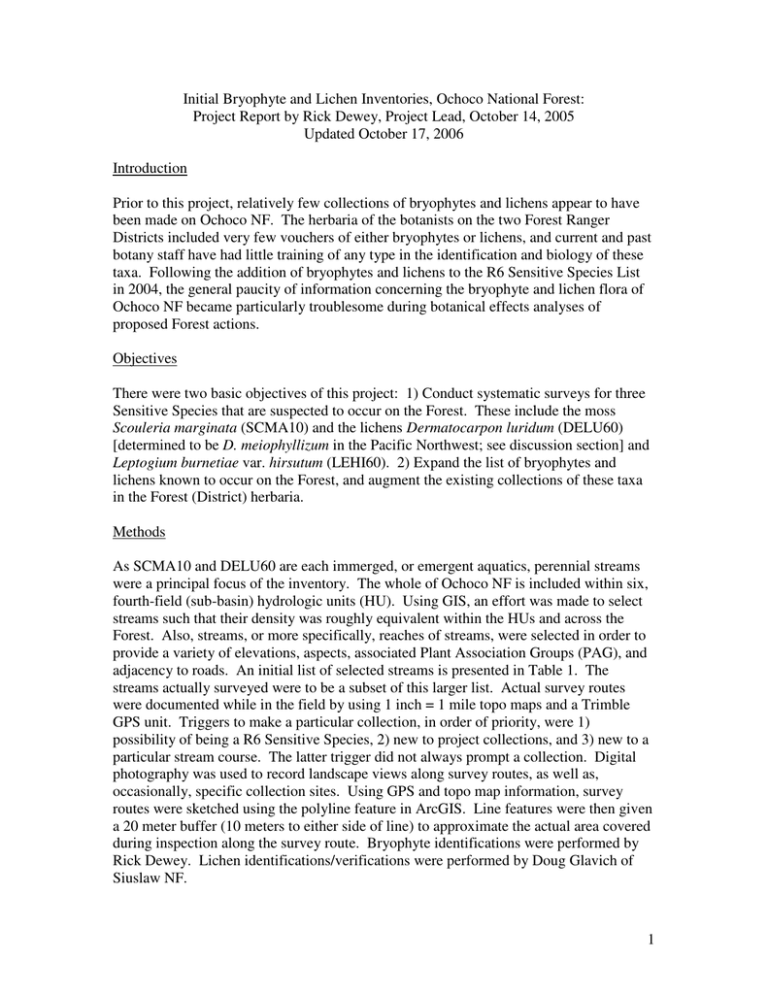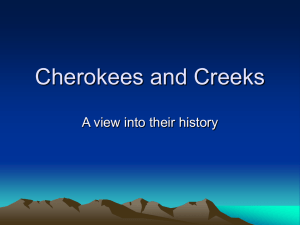Initial Bryophyte and Lichen Inventories, Ochoco National Forest:
advertisement

Initial Bryophyte and Lichen Inventories, Ochoco National Forest: Project Report by Rick Dewey, Project Lead, October 14, 2005 Updated October 17, 2006 Introduction Prior to this project, relatively few collections of bryophytes and lichens appear to have been made on Ochoco NF. The herbaria of the botanists on the two Forest Ranger Districts included very few vouchers of either bryophytes or lichens, and current and past botany staff have had little training of any type in the identification and biology of these taxa. Following the addition of bryophytes and lichens to the R6 Sensitive Species List in 2004, the general paucity of information concerning the bryophyte and lichen flora of Ochoco NF became particularly troublesome during botanical effects analyses of proposed Forest actions. Objectives There were two basic objectives of this project: 1) Conduct systematic surveys for three Sensitive Species that are suspected to occur on the Forest. These include the moss Scouleria marginata (SCMA10) and the lichens Dermatocarpon luridum (DELU60) [determined to be D. meiophyllizum in the Pacific Northwest; see discussion section] and Leptogium burnetiae var. hirsutum (LEHI60). 2) Expand the list of bryophytes and lichens known to occur on the Forest, and augment the existing collections of these taxa in the Forest (District) herbaria. Methods As SCMA10 and DELU60 are each immerged, or emergent aquatics, perennial streams were a principal focus of the inventory. The whole of Ochoco NF is included within six, fourth-field (sub-basin) hydrologic units (HU). Using GIS, an effort was made to select streams such that their density was roughly equivalent within the HUs and across the Forest. Also, streams, or more specifically, reaches of streams, were selected in order to provide a variety of elevations, aspects, associated Plant Association Groups (PAG), and adjacency to roads. An initial list of selected streams is presented in Table 1. The streams actually surveyed were to be a subset of this larger list. Actual survey routes were documented while in the field by using 1 inch = 1 mile topo maps and a Trimble GPS unit. Triggers to make a particular collection, in order of priority, were 1) possibility of being a R6 Sensitive Species, 2) new to project collections, and 3) new to a particular stream course. The latter trigger did not always prompt a collection. Digital photography was used to record landscape views along survey routes, as well as, occasionally, specific collection sites. Using GPS and topo map information, survey routes were sketched using the polyline feature in ArcGIS. Line features were then given a 20 meter buffer (10 meters to either side of line) to approximate the actual area covered during inspection along the survey route. Bryophyte identifications were performed by Rick Dewey. Lichen identifications/verifications were performed by Doug Glavich of Siuslaw NF. 1 Survey for LEHI60 was to occur in the riparian communities associated with SCMA10 and DELU60, as well in upland settings representing the range of Ochoco NF PAGs. This type of survey was intended to be in part opportunistic - occurring as a particular PAG was adjacent to a riparian survey route - and in a limited number of instances (e.g., Mt. Pisgah and the Lookout Mountain Management Area), independent of any adjacent perennial streams. Table 1. Initial set of streams selected for bryophyte/lichen surveys. Streams actually surveyed, based on available time, were to be a subset of this group. Streams are grouped by fourth field hydrologic unit (sub-basin). Upper John Day Badger/Bug/Hoffman Creeks East Fork Cottonwood Creek Owl/Black Canyon Creeks Lower John Day Bear Creek Bridge Creek West Branch Bridge Creek Trout Auger Creek Potlid Creek Trout Creek Lower Crooked Canyon Creek Crystal Creek Deer Creek Upper Crooked Big Spring Creek Brush Creek #2 Derr/Jackson/No Name Creeks Upper Crooked (Maury Mtns.) Faught Creek Klootchman Creek Maury Creek South Fork Crooked Beaverdam Creek Roba Creek Wolf Creek Rock/Baldy/Squaw Creeks South Fork Wind Creek East Fork Mill Creek Ochoco Creek West Fork Mill Creek Happy Camp Creek Howard Creek Peterson Creek Newsome Creek Wildcat Creek Wiley Creek 2 Results Surveys were conducted on Ochoco NF between June 13 and August 4, 2005. Information concerning survey locations is presented in Table 2 below. A map displaying survey routes is included in the Appendix. Table 2. Locations of bryophyte and lichen surveys on Ochoco NF in 2005. Surveys at each location were accomplished in a single day. Survey Acres and Survey Miles were generated by ArcGIS analysis. Survey Acres represent linear survey routes with a 20 meter buffer. All routes were fully walked except those at Derr/Jackson/No Name Creeks and Wolf Creek, where the multiple inventory sites were accessed by motor vehicle. Location Badger/Bug/Hoffman Creeks Beaverdam Creek Big Spring Creek Canyon Creek Derr/Jackson/No Name Creeks East Fork Cottonwood Creek Happy Camp Creek Owl/Black Canyon Creeks Roba Creek Rock/Baldy/Squaw Creeks South Fork Wind Creek Wolf Creek Total Survey Acres 11.6 6.4 11.3 5.7 34.6 39.4 14.3 20.0 9.6 18.9 22.7 64.6 259.1 Survey Miles 1.4 0.8 1.4 0.7 4.3 4.9 1.8 2.5 1.2 2.4 2.9 8.1 32.4 During the 12 days of surveys on Ochoco NF, 135 vouchers of lichens, and 350 vouchers of bryophytes were collected. In an approximate descending order of collection intensity, collections were made in the following PAGs: Moist Fir; Dry Fir; Douglas Fir; Subalpine; Moist Pine; Dry Pine; Non-Forested. Surveys were conducted in four of the six sub-basins represented on the Forest. The lichen collections were determined to include 21 genera and 40 species. Collected lichen taxa are presented in Table A1 of the Appendix. All bryophyte vouchers have been screened for R6 Sensitive Species, but species determinations have only yet been made for 155 of the 350 collections. Currently 30 moss genera including 49 different species/varieties, 14 liverwort genera including 18 species, and one hornwort species have been identified. An interim list of bryophyte determinations is included in Table A2 of the Appendix. The genera of the three target R6 Sensitive Species (Scouleria, Dermatocarpon and Leptogium) were collected. The target taxa Scouleria marginata and Leptogium burnetiae var. hirsutum were not detected. The target species Dermatocarpon meiophyllizum (see Discussion below) was collected at four sites in two sub-basins. 3 Discussion There are several points of note with regard to this project. 1) Dermatocarpon meiophyllizum. According to a 10/13/05 e-mail from Doug Glavich, "Dermatocarpon meiophyllizum is likely what has been called D. luridum (a sensitive species) in the Pacific Northwest. We surveyed known sites and random sites across the PNW for aquatic lichens and almost all Dermatocarpon found was ID'd as D. meiopyllizum by S. Heidmarsson in Iceland. No D. luridum was found." This new information was addressed in the paper: Glavich, D.A. & L.H. Geiser. 2004. Dermatocarpon meiophyllizum in the Pacific Northwest. Evansia 21 (3): 137-140. During this project, Dermatocarpon meiophyllizum was found along Baldy and Squaw Creeks within the Upper John Day sub-basin, and along Roba and Wolf Creeks in the South Fork Crooked sub-basin. According to Glavich (e-mail, 10/14/05), the Dermatocarpon meiophyllizum sites nearest those now known on Ochoco NF are on Deschutes NF, where two sites exist within the Three Sisters Wilderness Area, and a third site occurs on Snow Creek, on the Bend/Ft. Rock Ranger District. 2) Scouleria. Occurrences of the moss Scouleria aquatica were found within the Upper John Day sub-basin along Black Canyon Creek, Owl Creek, and Squaw Creek, and on Happy Camp Creek within the Upper Crooked sub-basin. The occurrences within the Upper John Day sub-basin are located on stream reaches with moderate gradients, brisk water velocity, and much immersed/emergent rock included in a small boulder, or larger, size class. The surveyed portion of Happy Camp Creek includes reaches with brisk water velocity as well as numerous reaches with rather slow-moving water. The type of reach in which Scouleria aquatica was collected is uncertain. The occurrence of Scouleria aquatica is significant in that it is usually present at sites where the R6 Sensitive Species, Scouleria marginata, occurs. 3) Riccia trichocarpa. This thallose liverwort was found at seven sites near three of the surveyed streams, within the Upper John Day and South Fork Crooked sub-basins. Prior to this project, the species was known in Oregon from two or three sites in Jackson Co., and a single site in Jefferson Co. on Deschutes NF. During a personal communication in 2004, John Christy, a bryologist with the Oregon Natural Heritage Program, suggested that Riccia trichocarpa should probably be added to ORNHP List 3, which would prompt further assessment of its status in Oregon. 4) Disturbance bryophytes. Several taxa of thallose liverworts were found at sites where ongoing disturbance by cattle was evident. Sphaerocarpos michelii was found at a single site, Fossombronia sp. at sites in three different stream drainages, and Riccia spp. were found in nearly all of the drainages surveyed. These taxa are typically found on relatively fine-textured, dense/compacted soils that are spring-damp/ summer-dry and wellilluminated. At most of the Ochoco NF sites where these taxa were observed, cattle grazing appeared to limit the height (and sometimes, density) of graminoids and forbs, allowing relatively high levels of light at the soil surface. It also was apparent from the 4 distribution of Riccia taxa along cattle trails, that these animals probably are effective spore dispersal vectors for these liverworts. 5) Leafy liverwort distribution. East of the Cascade crest, leafy liverworts are most likely to be found in cool, moist microsites within moist forest types. The rotten wood and duff-dwelling genera Lophozia, Cephalozia, Lophocolea and Jungermannia were found in only four or fewer of the surveyed stream drainages. Nearly all sites were located in moist microsites within the Moist Fir or Subalpine PAGs. 6) Bryophyte diversity in streams. In general, the diversity of bryophytes within low velocity, low gradient streams flowing through graminoid-dominated meadows is lower than that in briskly flowing, moderate-gradient streams with either little adjacent stream terrace, or with terraces occupied by a mix of graminoids and forbs. Briskly flowing streams, however, can differ markedly in their bryophyte diversity, and the underlying reasons are not readily apparent. For example, an abundance and diversity of bryophytes occur on the rock and wood in the surveyed reaches of Owl and Black Canyon Creeks. In contrast, the surveyed reaches Rock Creek, and especially, its tributary, Baldy Creek, which are physically similar to Owl and Black Canyon Creeks (although aspect and the riparian vascular plant communities are very different), are nearly devoid of bryophytes. 7) Subalpine Plant Association Group. Surveys within the Subalpine PAG were conducted only on portions of the relatively adjacent Bug and Hoffman Creeks. The surveyed portions of these creeks are not at high elevation (5200-5500 feet), but the creek drainages appear to collect unexpectedly cool and moist air. A number of moss genera (Eurhychium, Fissidens, Rhizomnium, Timmia) and liverwort genera (Cephalozia, Jungermannia, Lophocolea, Pellia) where were recorded here, but not in the other project surveys. 8) The extent of this project, while focusing on selected perennial stream courses, was to include all of Ochoco NF, including Paulina and Lookout Mtn. Ranger Districts, including the Maury Mtns. Surveys were essentially completed on Paulina RD - the eastern half of the Forest - but barely commenced on the Lookout RD. Failure to complete the project as planned was largely due to an unexpected reduction in the availability of the project lead. This, in turn, was due to 1) a major and unanticipated 11th hour need to support a large Deschutes NF fire salvage project between 7/5-9/9 and 2) recovery from an 8/21 motor vehicle accident. 5 Appendix Table A1. Checklist of eastside Cascades lichens. This table is presented here as received from Doug Glavich, a lichenologist on Suislaw NF. Column on left is based on Glavich's eastside field experience and frequency data from air quality monitoring plots on Deschutes NF. Taxa in blue are new to Glavich's list as result of this project's Ochoco NF collections. An "X" in the central column indicates presence of taxon in this project's lichen collections. Bold = common eastside cascades lichens Lichen Species Ahtiana sphaerosporella Alectoria imshaugii Alectoria sarmentosa Bryoria fremontii Bryoria fuscescens Bryoria glabra Bryoria pseudofuscescens Candelaria concolor Cladonia carneola Cladonia cenotea Cladonia chlorophaea Cladonia coniocraea Cladonia ecmocyna Cladonia fimbriata Cladonia transcendens Dermatocarpon meiophyllizum Dermatocarpon miniatum Dermatocarpon reticulatum Esslingeriana idahoensis Evernia prunastri Hypocenomyce scalaris Hypogymnia apinnata Hypogymnia enteromorpha Hypogymnia imshaugii Hypogymnia metaphysodes Hypogymnia occidentalis Hypogymnia physodes Karnefeltia (Cetraria) merrilli Leptogium subaridum Blue = new list additions (10/12/05) Ochoco NF Collection Notes X X X X X X X X X X X X X Sensitive, misnamed as D. luridum in the Pacific Northwest. Sm fragment in mixed collection X X X X 6 Letharia columbiana Letharia vulpina Melanelia elegantula Melanelia exasperatula Melanelia subelegantula Melanelia subolivacea Nephroma parile Nodobryoria abbreviata Nodobryoria oregana Parmelia hygrophila Parmelia sulcata Parmeliopsis ambigua Parmeliopsis hyperoptera Peltigera elisabethae Peltigera rufescens Peltigera venosa Physcia adscendens Platismatia glauca Ramalina farinacea Tuckermannopsis (Cetraria) chlorophylla Tuckermannopsis (Cetraria) orbata Tuckermannopsis (Cetraria) platyphylla Umbilicaria hypoborea Umbilicaria terrafacta Usnea lapponica Usnea scabrata Vulpicida canadensis Xanthoria fallax Xanthoria fulva X X X X X X X X X X X X X X X X X X X X X X X 7 Table A2. Interim list of bryophytes collected during this project. Names in parentheses are tentative, or otherwise in need of resolution. Ochoco NF mosses (35 genera, 10/17/2006) Amblystegium riparium Atrichum selwynii Aulacomnium androgynum Aulacomnium palustre Brachythecium albicans Brachythecium erythrorrhizon Brachythecium frigidum Brachythecium salebrosum Brachythecium velutinum var. venustum Bryoerythrophyllum recurvirostre Bryun creberrimum Bryum pseudotriquetrum Bryum sp. [very decurrent] Ceratodon purpureus Dicranoweisia crispula var. contermina Dicranum tauricum Drepanocladus aduncus Drepanocladus uncinatus var. uncinatus Dryptodon patens Eurhychium praelongum var. stokesii Fissidens bryoides Fontinalis antipyretica Fontinalis neo-mexicana Funaria hygrometrica Grimmia montana Homalothecium aeneum Hygrohypnum ochraceum Leptobryum pyriforme Lescurea incurvata var. incurvata Lescurea radicosa var. radicosa Orthotrichum affine Orthotrichum laevigatum Orthotrichum rivulare 8 Orthotrichum (rupestre) Orthotrichum (speciosum) Phascum cuspidatum Philonotis fontana var. americana Plagiomnium insigne Plagiomnium medium Pohlia nutans Polytrichadelphus lyallii Polytrichum juniperinum Polytrichum piliferum Rhizomnium magnifolium Rhizomnium pseudopunctatum Rhytidiadelphus triquetrus Roellia roellii Schistidium apocarpum Schistidium rivulare [Grimmia alpicola var. rivularis in Lawton] Scleropodium obtusifolium Scouleria aquatica Timmia austriaca Tortula ruralis Ochoco NF liverworts (14 genera, 10/17/2006) Asterella gracilis Cephalozia (cantenulata) Cephaloziella (stellulifera). Chiloscyphus polyanthos Fossombronia sp. Jungermannia exsertifolia Jungermannia lanceolata Lophocolea minor Lophozia incisa Lophozia ventricosa Marchantia polymorpha Pellia endiviifolia Porella cordaeana Riccia beyrichiana Riccia sorocarpa Riccia trichocarpa Scapania umbrosa Scapania undulata Sphaerocarpos michelii Ochoco NF hornworts Anthoceros sp. 9 10 A3. Location of 2005 bryophyte/lichen survey routes on Ochoco NF. 11






